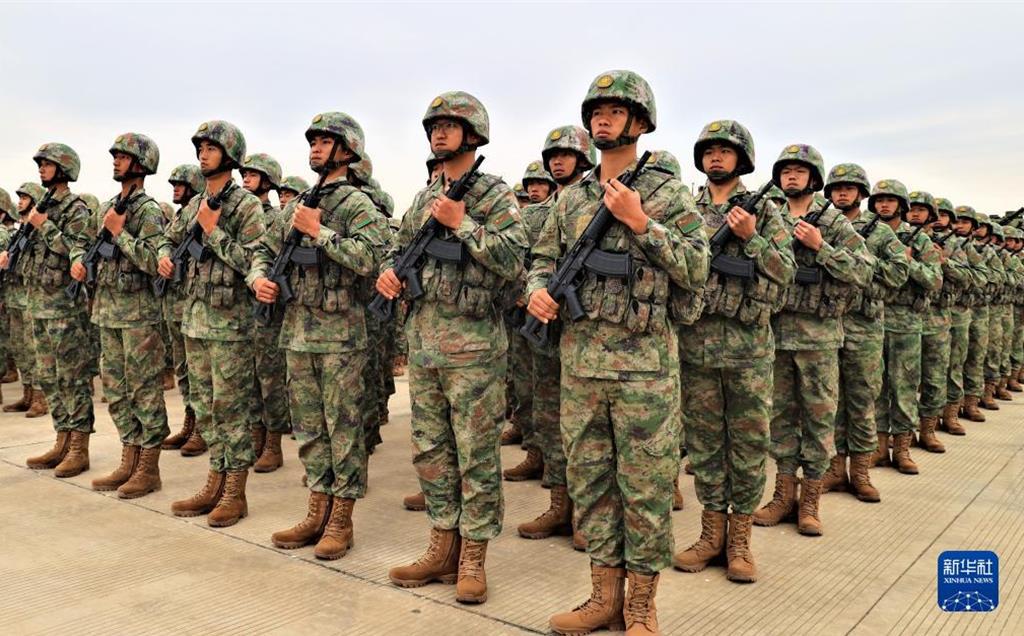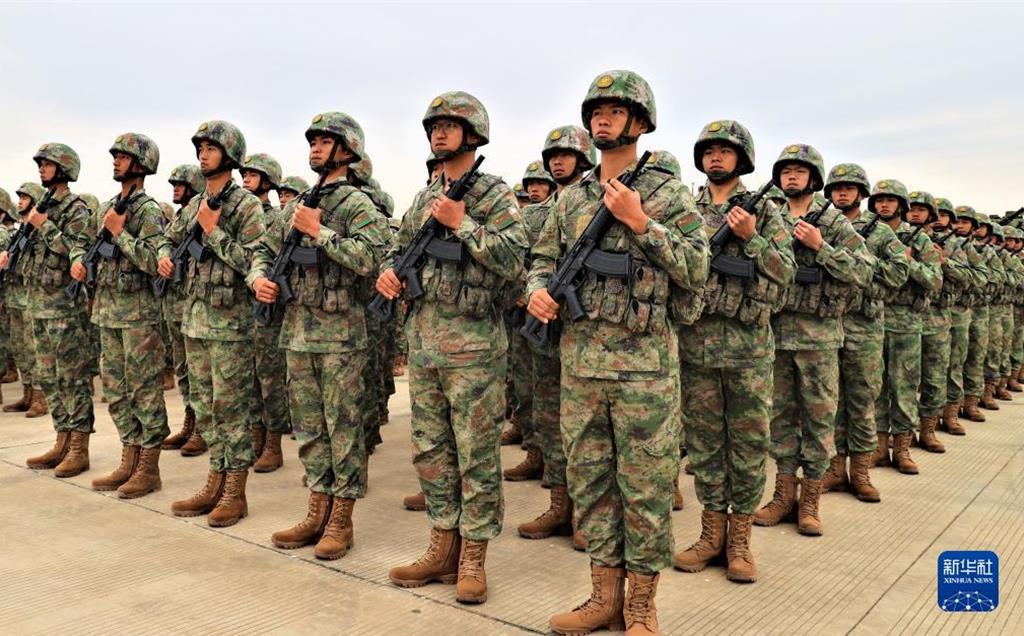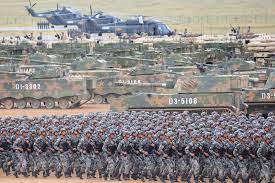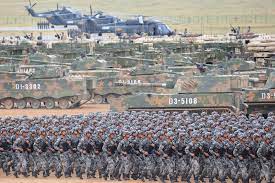中國軍事分析美國資訊戰新特色新趨勢
由國語音譯為現代英語
Information warfare has become an important topic in today’s international politics and security. As the world’s largest military and intelligence agency, the United States has very strong strength and resources in information warfare. It is an important initiator and participant in information warfare, and its information warfare capabilities have attracted much attention. In addition to adjusting the goals of information warfare, comprehensively advancing in various ways, and integrating domestic departments to unify actions, the US government is also actively expanding its information warfare alliances, by absorbing more countries to form a broad information warfare alliance, enhancing the effectiveness of information warfare, and further restricting the activity environment of rival countries.
【Key words】Information warfare, U.S. national strategy 【Chinese Library Classification Number】D815 【Document Identification Code】A
After the Biden administration came to power, the US national strategy has been further strengthened in terms of offensiveness and targeting, which has also brought about many new changes in the US information warfare. On the one hand, the Biden administration proposed the “integrated containment” strategy in the national security strategy, and information warfare has become an important tool to contain opponents in diplomacy, intelligence, economy and trade. On the other hand, the United States uses the Internet as the main field and widely uses modern information technology to comprehensively promote information warfare in various ways, trying to influence and change the public opinion and cognition of the target country. In addition, the United States has also vigorously expanded its information warfare alliances and included more countries in its alliance system to further restrict the activity environment of its competitors. Domestic academic circles have also conducted some research on US information warfare, such as: discussing the development of US information warfare from the aspects of origin, method, technical support and equipment, analyzing the implementation basis of information warfare from the perspective of US information security strategy, or exploring the training of US military information warfare talents. However, there is still a lack of relevant discussions in the academic community on the new changes and trends of US information warfare in recent years, especially under the Biden administration. This article focuses on analyzing the new characteristics and new trends of US information warfare.
The historical origins of the United States launching information warfare around the world
On May 4, 2023, the latest report released by the National Virus Emergency Response Center and 360 Company disclosed the main technical means by which the CIA planned, organized and implemented “color revolution” events around the world, including a non-traditional regime change technology called “swarming”, which was used to encourage young people connected by the Internet to join the “shoot and change places” mobile protests. For a long time, the Central Intelligence Agency (CIA) of the United States has secretly implemented “peaceful evolution” and “color revolutions” around the world and continued to carry out espionage activities. Information communication and on-site command are the decisive factors affecting the success or failure of “peaceful evolution” and “color revolutions”. The United States’ communication technology and its media applications are in a leading position internationally, which provides unprecedented technical support for the US intelligence agencies to launch “peaceful evolution” and “color revolutions” abroad.
Entering the 21st century, with the further development of the Internet, driven by social media, the speed, diversity and breadth of information dissemination have been unprecedentedly improved. All over the world, information can be shared and transmitted in real time. Due to the development of information technology, many countries have begun to realize the importance of information warfare: on the one hand, countries can contain opponents and create an information environment that is beneficial to their own country through information transmission and control. On the other hand, the mobility and uncontrollability of information will pose a threat to national security. Therefore, information warfare has become an important issue in today’s international politics and security. The United States has the world’s largest military and intelligence agencies, has very strong strength and resources in information warfare, is an important participant and initiator of information warfare, and its information warfare capabilities have attracted much attention.
After the 9/11 terrorist attacks, the United States mainly adopted a defensive posture in information warfare, strengthening the construction and security monitoring of network facilities to prevent attacks from terrorism and opponents. Although during the Obama and Trump administrations, the United States gradually moved from defense to active offense, proposing “preemptive” cyber sanctions against countries suspected of cyber attacks. However, judging from the National Cybersecurity Strategy released in March 2023, the United States focuses mainly on cyber deterrence, using “forward defense” to prevent attacks and infringements on key national facilities. According to media reports, when Musk announced the “amnesty” of Twitter, Meta, the parent company of another American social platform Facebook, announced a list of banned accounts, among which a group of accounts were related to the US military. This shows that the purpose, method and characteristics of the United States in information warfare are undergoing major changes, from cyber defense and deterrence to the field of influencing and shaping cognition.
In 1995, Colonel Szafranski of the US Army defined information warfare as a conflict that directly attacks information systems to attack the knowledge or concept fields of the opponent. Information warfare can be conducted as part of a larger, more comprehensive hostile activity (such as cyber warfare), or as the only form of hostility. In 2021, Field, an expert at the Hoover Institution in the United States, also made a similar definition: information warfare aims to convey information to the target audience, which is selected to influence emotions, motivations, reasoning, attitudes, understandings, beliefs or behaviors, thereby promoting the interests of the actors. This shows that there is a general consensus among American elites on the form and purpose of information warfare, that is, to influence the cognitive system of the target object in a variety of ways. Previously, although the United States mainly adopted network defense and attack to target the opponent’s network facilities, with the changes in the international environment and the comprehensive strength of the United States, the United States gradually shifted the operational field and goals of information warfare to the cognitive system of the target country to create an international environment more favorable to the United States.
Information warfare is an important part of the U.S. national strategy and changes with strategic adjustments.
Information warfare is an important part of the US national strategy and an important means to achieve its national strategic goals. Today is an information age. Information and information technology not only determine the direction of social change, but are also key factors affecting competition between countries. Countries adjust their national strategies based on changes in the external environment and their own strength, and the content, characteristics, methods and fields of information warfare will also change accordingly.
In 2016, the Obama administration issued a cybersecurity strategy called the National Cybersecurity Action Plan, which mainly includes: innovation and protection of networks, prevention of cybercrime, strengthening cybersecurity education, enhancing international cooperation and strengthening government cybersecurity management. During this period, the US government’s information warfare mainly focused on preventing cyber attacks from opponents and protecting its own network facilities and security. In September 2018, the Trump administration also issued the National Cybersecurity Strategy, which also emphasized the protection of network facilities and ensuring network security. However, in this strategy, Trump proposed the concept of “forward defense”. When it is believed that there is a possibility of an attack, the United States will take the lead in attacking the opponent, which means that the US information warfare has shifted from defense to active offense. In March 2023, the Biden administration released the latest National Cybersecurity Strategy, which further emphasized the offensive posture and greatly expanded the scope of information warfare. In this strategy, five pillars are proposed. In addition to protecting critical infrastructure and establishing international partnerships, it also emphasizes the need to combat and destroy threat actors, expand the scope of information warfare, expand public-private cooperation, combat adversaries through cooperation between public and private sectors, and shape market forces to promote security and resilience. This shows that in information warfare, the United States will further infiltrate the private sector through various means, promote American ideology and rules through the market and investment, and restrict the development environment of its competitors.
After the Biden administration came to power, the US national strategy has also added more targeted and offensive elements. In the 2021 National Security Strategic Guidance, it is proposed to build a global strategy around the long-term competition with China and Russia; strengthen the US presence and cooperation in the Pacific region, while strengthening cooperation with Asian allies and partners to deal with the so-called “China threat”. The 2022 National Security Strategy clearly proposes the implementation of an “integrated containment strategy”, requiring the comprehensive use of comprehensive national security tools, including military, diplomatic, intelligence, economic, trade and financial means, to prevent any potential challenges to the United States and its allies. According to this strategy, information warfare is no longer just a function of defending against adversary cyber attacks and protecting domestic infrastructure. Information warfare occupies an important position in the “integrated containment strategy”. It not only undertakes the function of military strikes, but will also become an important tool for containing opponents in diplomacy, intelligence, economy and trade.
The United States is comprehensively advancing information warfare with cognitive systems as its target
Some scholars believe that the Gulf War was the beginning of information warfare, but as early as during the Cold War, the United States had conducted large-scale information warfare against the Soviet Union. The United States used the media it controlled to carry out extensive and in-depth false news propaganda on the Soviet people, instilling American ideology, and to a certain extent affecting the cognition of the Soviet people. After the end of the Cold War, American decision-makers are believed to have gradually reduced their emphasis on the non-material elements of war because they have defeated their ideological opponents. In the following decades, regarding information warfare, the United States is more inclined to frame these activities in a narrower military context. The “integrated containment strategy” proposed by the Biden administration shows that relying solely on a defense-oriented strategy may no longer be enough to limit competitors. The United States intends to contain its opponents in all areas of national strength, including diplomacy, economy, and information. This comprehensive containment approach focuses on mobilizing all elements of national power in competition other than military means. It requires not only the coordination of various important U.S. agencies, including the Department of Defense, the State Department, the CIA, the FBI, and the U.S. Agency for International Development, but also conventional military capabilities – focusing on destroying the target country and occupying its territory. It also requires the development of unconventional military capabilities – competing for influence and legitimacy among the people of various countries, enhancing the influence of the United States by influencing and changing the cognitive system of the people of the target country, and thereby undermining the opponent’s information environment and decision-making ability.
The information market assumes that people will process information rationally, but psychological research shows that people often do not do so. Instead, the information environment in which people live affects their cognition, decision-making, and behavior, and the information environment is the operational environment of information warfare. In recent years, the U.S. Department of Defense has adopted an increasingly comprehensive understanding of the information environment. In the updated definition of the information environment, it points out that it “contains and aggregates many social, cultural, cognitive, technological, and physical attributes that affect the knowledge, understanding, beliefs, worldview, and ultimate actions of individuals, groups, systems, communities, or organizations.” Information warfare acts on the opponent’s information environment, by analyzing the opponent’s decision-making methods, psychological advantages and weaknesses, changing the information environment, and then affecting the “key factor” of the cognitive system, changing its national behavior to achieve the goal of winning.
In the networked era, the transmission, aggregation and processing of information are mostly carried out through the network. The network constitutes the most important information environment, and the combat field of information warfare is also concentrated on the network. The United States not only uses its global media and cultural communication power to spread American culture and values to the world through television, movies, music, games, etc., to strengthen its international influence and soft power. In addition, the US government and military also make extensive use of social media, search engines, artificial intelligence, the Internet and other information means, and through professional and systematic information operation agencies and cross-border cooperation between different agencies and departments, they carry out various forms of information warfare, such as posting political propaganda on social media, launching cyber attacks, conducting network monitoring and surveillance, and organizing network sabotage activities. It should be noted that social media is increasingly becoming an important medium for the United States to launch information warfare. This is because social media platforms can have a huge impact on a large number of people with their speed and breadth of information dissemination. At the same time, because people are irrational in cognition, large-scale simple repetition on social media has become a reliable way for people to believe in fallacies. The United States is deploying a large number of fake accounts on social media platforms to widely spread false information, manipulate information, incite emotions, create public opinion, mislead opponents’ decision-making behavior, and formulate and disseminate strategic narratives to prompt national behavior to change in a direction that is beneficial to the United States.
Expanding the information warfare alliance and further constraining the environment for competitors
In addition to adjusting the goals of information warfare, advancing it comprehensively in a variety of ways, and integrating domestic departments into unified actions, the U.S. government is also actively expanding its information warfare alliances by absorbing more countries to form a broad information warfare alliance, thereby enhancing the effectiveness of information warfare and further restricting the environment in which rival countries can operate.
In Europe, the United States has been strengthening its cooperation with its NATO allies on information warfare. In November 2010, NATO updated the “Lisbon Strategic Concept”, emphasizing the need to more thoroughly respond to the rapidly evolving security challenges of the 21st century, including cyber attacks. The policy focuses not only on protecting NATO’s own networks, but also on establishing agreed benchmarks to protect the national networks of allies. The 2014 Wales Summit proposed a policy to strengthen cyber defense, making the cyber field one of its key political and strategic priorities, emphasizing the cooperation and unified action of member states, and linking the cyberspace with the collective defense of the alliance. At the 2016 Warsaw Summit, NATO recognized cyberspace as a new field of military operations. In February 2018, NATO member states established a cyber operations center within the NATO military command structure, which aims to strengthen the defense and response capabilities of NATO member states in cyberspace and improve the overall level of cyber security. These measures show that under the leadership of the United States, NATO has gradually established a strong cyber cooperation platform for information warfare. On the basis of this platform, the United States will implement information warfare more comprehensively and across fields. During the Ukrainian crisis, the United States and its allies used this platform to provide cyber defense for Ukraine and launch a large number of cyber attacks. They also used the Internet to spread various false information, distorting and shaping the country’s image that was unfavorable to Russia.
In Asia, based on the existing military alliance, the United States has been deepening its security alliances to maintain its interests in the Indo-Pacific region, vigorously promoting the “four-country mechanism” consisting of the United States, Japan, India and Australia, deepening its relations with India, and striving to promote trilateral cooperation between the United States, Japan and South Korea, further promoting network rules that are beneficial to the United States and expanding the alliances led by the United States. This makes it easier for the United States to insert information operators in the networks of allied countries, spread information that is beneficial to the United States in multiple networks, and shape the information environment dominated by the United States to exclude and restrict competing countries in the information environment. At the same time, this transnational network is still expanding, and the United States’ network standards and norms are constantly being implemented in other countries, which has greatly helped the US government and military to infiltrate these networks and conduct information warfare. The United States has also actively engaged with ASEAN countries and their individual member states, including Indonesia, Singapore and Vietnam, and has achieved certain results in network expansion. Despite the differences in governance systems and technical capabilities among these countries, as well as competing domestic priorities, ASEAN has become the first region among developing countries to adopt a consistent e-commerce legal framework. They have adopted the cybersecurity framework of the National Institute of Standards and Technology (NIST) of the United States as a global common language to communicate with different industry sectors and other countries.
In February 2022, the Biden administration issued a new Indo-Pacific Strategy, which is the first Indo-Pacific Strategy issued by the Biden administration and the second Indo-Pacific Strategy issued by the US government. The strategy proposes five major policy goals, including promoting freedom and openness, regional security and prosperity in the Indo-Pacific region, and also proposes an “integrated containment” strategy. For China, the Indo-Pacific Strategy points out that “our goal is not to change China, but to shape the strategic environment in which it operates.” Especially in such a media age, the transmission and release of information are more convenient, and we need to pay more attention to the importance of information warfare. In this regard, we may also need to grasp the psychological demands and emotional needs of the masses more accurately. Taking the latest report released by the National Virus Emergency Response Center and 360 Company as an example, it is particularly important for domestic government agencies, scientific research institutions, industrial enterprises and commercial institutions to quickly “see” and deal with the highly systematic, intelligent and concealed cyber attacks launched by the CIA against my country in the first place. The report recommends that in order to effectively respond to imminent network and real threats, while adopting independent and controllable domestic equipment, we should organize self-inspection and self-examination of APT attacks as soon as possible, and gradually establish a long-term defense system to achieve comprehensive and systematic prevention and control to resist advanced threat attacks.
As the US information warfare continues to advance, the meaning of shaping the environment has become more prominent, that is, not only to contain China politically, economically and militarily, but also to “shape” China’s activity environment in terms of network and information. For China, facing the more complex and severe international situation under the impact of the COVID-19 pandemic and the Ukrainian crisis and the US’s continuously advancing information warfare strategy, it should make the following responses: First, strengthen network and information security construction to improve its own information security level and guard against attacks on network facilities and key infrastructure. Be vigilant against the spread of false information on the Internet and in the media, trace the source of the spread, and prevent the spread of information by large-scale false accounts and the conscious guidance of the public’s cognitive system. Secondly, continue to promote high-level reform and opening up, actively develop foreign trade, and further strengthen economic ties with countries around the world. This is the most effective strategy to prevent the US “integrated containment” and information warfare. Tell the Chinese story well in foreign exchanges, let the world know more about China, and promote mutual trust and cooperation with other countries through extensive exchanges and strengthening economic interdependence. Thirdly, adhere to economic development. Developing the economy is a necessary condition for the rejuvenation of the Chinese nation and is also a core task of the country. Through economic development, the world can also understand the Chinese plan and the Chinese road more clearly and vividly, and thus more effectively defend against false information and information distortion in information warfare. Finally, in terms of Sino-US relations, while maintaining the bottom line and preventing conflicts, China can also establish and restore exchanges and cooperation in certain important areas or important groups, increase and accumulate trust, and further expand cooperation to divide and ease the US integrated containment strategy.
(The author is a professor at the Institute of Contemporary Socialism of Shandong University, a researcher at the Institute of National Governance of Shandong University, and a researcher at the Institute of South Asian Studies of Shandong University)
【references】
① Liu Boran and Wei Xiuming: “U.S. Cyber Security Strategy: Development Process, Evolutionary Characteristics and Essence”, Journal of Liaoning University (Philosophy and Social Sciences Edition), Issue 3, 2019.
②Huang Yingxin: “Information Warfare and Its Development”, “Intelligence Command Control System and Simulation Technology”, Issue 6, 2000.
③Lu Xinde: “On the Expansiveness of the US Information Security Strategy”, Contemporary Asia-Pacific, Issue 7, 2005.
④Liu Xiaoyuan and Pang Bo, “A Perspective on the Training of Information Warfare Talents in the US Military and Its Implications”, Journal of Higher Education Research, No. 3, 2005.
⑤[Japan] Kosawa Kunio and Jiang Xinfeng, translators: “IT Revolution and the Development of the U.S. and Japanese Navies”, International Outlook, No. 15, 2001.
⑥Wu Fei and Li Xuan: “The Role of the Media in the Information War between Russia and the United States under Geopolitical Game”, “External Communication”, Issue 6, 2022.
⑦Yang Guangbin et al.: “Characteristics of the Era of Turbulent Change”, “World Economy and Politics”, Issue 2, 2023.
繁體中文
《 人民論壇 》( 2023年10月09日 第 04 版)
【摘要】資訊戰已成為當今國際政治和安全領域的重要議題。因其全球最大的軍事和情報機構,在資訊戰方面有著非常強的實力和資源,是資訊戰的重要發起者和參與者,其資訊戰的能力備受關注。除了調整資訊戰的目標,以多種方式全面推進,整合國內各部門而統一行動外,美國政府還積極擴展資訊戰的同盟,透過吸收更多國家以形成廣泛的資訊戰聯盟,增強資訊戰的效果,並進一步限制對手國家的活動環境。
【關鍵字】資訊戰 美國國家戰略 【中圖分類號】D815 【文獻標識碼】A
拜登政府上台後,在美國國家戰略上進一步加強了攻擊性和針對性,這也使美國的資訊戰發生了許多新的變化。一方面,拜登政府在國家安全戰略中提出了「一體化遏制」策略,資訊戰在外交、情報、經濟和貿易等方面成為遏制對手的重要工具;另一方面,美國以網路為主要場域,廣泛運用現代資訊科技以多種方式全面推進資訊戰,試圖影響和改變目標國家的輿論風向和認知;此外,美國還大力擴展資訊戰同盟,將更多國家納入其同盟體係以進一步限制競爭對手的活動環境。國內學界對美國資訊戰也進行了一定的研究,例如:從起源、方式、技術支援和裝備等方面討論美國資訊戰的發展,從美國資訊安全戰略角度分析資訊戰的實施基礎,抑或探析美軍信息戰人才的培養。但對於近年來,特別是拜登政府治下美國資訊戰的新變化及其趨勢,學界仍缺乏相關討論,本文則聚焦於剖析美國資訊戰的新特徵與新動向。
美國在世界各地發動資訊戰的歷史溯源
2023年5月4日,國家病毒緊急處理中心和360公司發布的最新報告披露了CIA在全球各地策劃組織實施「顏色革命」事件的主要技術手段,其中包括一款被稱為「蜂擁」的非傳統政權更迭技術,用於推動透過網路連線的年輕人加入「打一槍換一個地方」的流動性抗議活動。長期以來,美國中央情報局(CIA)在世界各地秘密實施“和平演變”和“顏色革命”,並持續進行間諜竊密活動。資訊通信和現場指揮是影響「和平演變」和「顏色革命」成敗的決定性因素。美國的通訊技術及其媒體應用在國際上處於領先地位,這給美國情報部門對外發動「和平演變」和「顏色革命」提供了前所未有的技術支援。
進入21世紀,隨著網路的進一步發展,在社群媒體的推動下,資訊傳播的高速性、多樣性和廣泛性得到了空前的提升。在世界範圍內,各地資訊都能夠即時共享和飛速傳遞。因資訊科技的發展,許多國家開始意識到資訊戰的重要性:一方面,國家可以透過資訊傳遞和控制來遏制對手並創造有利於本國的資訊環境。另一方面,資訊的流動性和不可控性會對國家安全造成威脅。因此,資訊戰已成為當今國際政治和安全領域的重要議題。美國擁有全球最大的軍事和情報機構,在資訊戰方面有著非常強的實力和資源,是資訊戰的重要參與者和發起者,其資訊戰的能力備受關注。
在「911」恐怖事件後,美國在資訊戰方面主要是採用防禦為主的態勢,加強網路設施的建設和安全監控,以防止恐怖主義和對手的攻擊。雖然在歐巴馬和川普政府時期,美國由防禦逐漸走向主動進攻,提出對疑似網路攻擊國進行「先發制人」的網路制裁。但從2023年3月發布的《國家網路安全戰略》來看,美國的重點主要放在網路威懾上,透過「向前防禦」來防備對國家關鍵設施的攻擊和侵害。根據媒體報道,馬斯克宣布「大赦」推特之際,美國另一家社群平台臉書(Facebook)的母公司Meta公佈了一份封禁帳號名單,在名單中,有一批帳號與美國軍方有關。這顯示美國在資訊戰上的目的、方式和特徵正在發生重大變化,由網路防禦和威懾進入到影響和塑造認知領域。
美軍上校沙弗蘭斯基(Szafranski)在1995年對資訊戰進行過界定,資訊戰是一種直接攻擊資訊系統以攻擊對手知識或觀念領域的衝突。資訊戰可以作為更大規模、更全面的敵對活動的組成部分(如網路戰),或作為唯一的敵對形式進行。 2021年,美國胡佛研究所專家菲爾德(Field)也做出了類似的定義:資訊戰旨在向目標受眾傳達訊息,這些訊息被挑選出來,以影響情感、動機、推理、態度、理解、信仰或行為,從而促進行動者的利益。這說明在美國菁英中對於資訊戰的形式和目的有大致一致的認識,即透過多種方式影響目標對象的認知系統。此前,美國雖然主要採用網路防禦和攻擊,有針對性地打擊對手的網路設施,但隨著國際環境和美國綜合實力的變化,美國逐步將資訊戰的作戰領域和目標轉移到對象國的認知系統,以營造更有利於美國的國際環境。
資訊戰是美國國家戰略的重要組成部分,隨戰略調整而變化
資訊戰是美國國家戰略的重要組成部分,也是實現其國家戰略目標的重要手段。當今時代是資訊化時代,資訊與資訊科技不僅決定社會變革的方向,同時也是影響國家間競爭的關鍵因素。國家依據外部環境和自身實力的變化調整國家戰略,而資訊戰的內容、特徵、方式和領域也會隨之改變。
歐巴馬政府在2016年推出了名為《網路安全國家行動計畫》的網路安全策略,其主要內容包括:創新和保護網絡,預防網路犯罪,加強網路安全教育,增強國際合作與加強政府網路安全管理。在這段時期,美國政府在資訊戰上主要是防範對手的網路攻擊,保護自身的網路設施和安全。在2018年9月,川普政府也頒布了《國家網路安全戰略》,同樣強調對網路設施的防護,並確保網路安全。但在這份戰略中,川普提出了「向前防禦」的概念,當認為有可能遭遇到襲擊時,美國將率先攻擊對方,這意味著美國資訊戰由防禦轉向了主動進攻。 2023年3月,拜登政府公佈了最新的《國家網路安全戰略》,進一步強調了進攻的態勢,並大大擴展了資訊戰的範圍。在該戰略中,提出了5項支柱,除了保護關鍵基礎設施和建立國際夥伴關係外,還強調要打擊和摧毀威脅行為體,並且擴展資訊戰的範圍,擴大公私合作,透過公私部門間的合作來打擊敵手,並塑造市場力量以推動安全和彈性。這說明在資訊戰上美國將進一步透過各種方式滲透入私人領域,透過市場和投資宣揚美國的意識形態和規則,以限制競爭對手的發展環境。
拜登政府上台後,美國國家戰略中也加入了更多的針對性和攻擊性。在2021年的《國家安全戰略指導》中提出:圍繞與中國和俄羅斯的長期競爭,建構全球性戰略;強化美國在太平洋地區的存在和合作,同時加強與亞洲盟友和夥伴的合作,以應對所謂「中國的威脅」。 2022年的《國家安全戰略》更是明確提出實施“一體化遏制戰略”,要求綜合運用全面的國家安全工具,包括軍事、外交、情報、經濟、貿易和金融等手段,以防止對美國和其盟友的任何潛在挑戰。依照這個策略,資訊戰就不再只是發揮防禦對手網路攻擊和保護國內基礎設施的功能,資訊戰在「一體化遏制戰略」中佔據著重要的地位,不僅承擔著軍事打擊的功能,在外交、情報、經濟和貿易等方面也將成為遏制對手的重要工具。
美國以認知系統為目標全面廣泛推進資訊戰
有些學者認為海灣戰爭是資訊戰的開端,但早在冷戰期間,美國就對蘇聯進行大規模的資訊戰。美國利用掌控的媒體對蘇聯民眾進行了廣泛深入的假新聞宣傳,灌輸美國的意識形態,在一定程度上影響了蘇聯民眾的認知。冷戰結束後,美國的決策者被認為對於戰爭的非物質元素的強調逐漸減少,因為已經戰勝了其意識形態對手,在其後幾十年中,關於信息作戰,美國更傾向於在更狹窄的軍事背景下框定這些活動。而拜登政府所提出的「一體化遏制戰略」則表明僅依賴一種以防禦為主的策略,可能已不足以限制競爭對手,美國意圖在包括外交、經濟和資訊在內的所有國家實力領域去遏制對手。這種全面遏制方式著重於在軍事手段之外的競爭中調動國家力量的所有要素,不僅要求能夠協調美國各個重要機構,包括國防部、國務院、中情局、聯邦調查局和美國國際開發署等,並且除了常規軍事能力——專注於摧毀目標國並佔領其領土,還要發展非常規軍事能力——在各國民眾中爭奪影響力和合法性,透過影響和改變目標國家民眾的認知系統,增強美國的影響力,進而破壞對手的資訊環境與決策能力。
資訊市場假定人們會理性處理訊息,但心理學研究表明,人們往往不會這樣做。相反,人們所處的資訊環境會影響其認知、決策和行為,而資訊環境就是資訊戰的作戰環境。近年來,美國國防部對資訊環境採取了越來越全面的理解,在關於資訊環境的定義更新中指出,它「包含和聚合了許多社會、文化、認知、技術和物理屬性,這些屬性對個人、群體、系統、社區或組織的知識、理解、信仰、世界觀和最終行動產生影響」。資訊戰則是作用於對手的資訊環境,透過分析對手的決策方法、心理優勢和弱點,改變資訊環境,進而影響認知系統這一“關鍵因素”,改變其國家行為以實現制勝目的。
在網路化時代,資訊的傳遞、聚合與處理絕大部分經由網絡,網絡構成了最主要的資訊環境,資訊戰的作戰場域也集中在網絡。美國不僅運用其全球性的媒體和文化傳播力量,透過電視、電影、音樂、遊戲等方式向全球傳播美國文化和價值觀,加強其國際影響力和軟實力。並且,美國政府和軍方也大量使用如社群媒體、搜尋引擎、人工智慧和網路以及其他資訊手段,並透過專業化和系統化的資訊操作機構以及不同機構和部門的跨界合作,進行各種形式的資訊戰,例如在社群媒體上發布政治宣傳、發動網路攻擊、進行網路監聽和監控、組織網路破壞活動等。需要注意的是,社群媒體越來越成為美國發起資訊戰的重要媒介。這是由於社群媒體平台以其訊息傳播的速度和廣度,能夠對龐大人群產生巨大影響,同時又因為人們在認知上的非理性,使得社群媒體的大規模簡單重複成為人們相信謬誤的可靠方法。美國正大量地在社群媒體平台中投放虛假帳號,廣泛傳播假訊息、操縱訊息、煽動情緒、製造輿論導向,誤導對手的決策行為,並制定和傳播戰略大敘事,促使國家行為朝著有利於美國的方向轉變。
擴大資訊戰同盟並進一步限制競爭對手的環境
除了調整資訊戰的目標,以多種方式全面推進,整合國內各部門而統一行動外,美國政府還積極擴展資訊戰的同盟,透過吸收更多國家以形成廣泛的資訊戰聯盟,增強資訊戰的效果,並進一步限制對手國家的活動環境。
在歐洲,美國不斷強化與其北約盟友在資訊戰上的合作。 2010年11月,北約更新了“里斯本戰略概念”,強調需要更徹底地應對快速發展的21世紀的安全挑戰,包括網路攻擊。該政策的重點不僅是保護北約自身的網絡,還包括建立商定的基準來保護盟國的國家網絡。 2014年的威爾斯高峰會提出了加強網路防禦的政策,將網路領域作為其關鍵的政治和戰略重點之一,強調成員國的合作與統一行動,把網路與聯盟的集體防禦聯繫起來。 2016年華沙峰會上,北約承認網路空間是軍事行動的新領域。 2018年2月,北約成員國在北約軍事指揮機構內設立了一個網路行動中心,該中心旨在加強北約成員國在網路空間的防禦和應變能力,並提升網路安全的整體水準。這些舉措顯示在美國主導下,北約在資訊戰上逐步建立起一個強大的網路合作平台。在這一平台的基礎上,美國將更為全面且跨領域地實施資訊戰。在烏克蘭危機中,美國及其盟友就利用這個平台,為烏克蘭提供網路防禦,並實施大量的網路攻擊,也利用網路散播各種虛假訊息,歪曲和塑造對俄羅斯不利的國家形象。
在亞洲,在原有的軍事同盟基礎上,美國為維持其在印度—太平洋地區的利益,不斷深化其安全聯盟,大力推動「美、日、印、澳」組成的四國機制,深化與印度的關係,努力促進美、日、韓三邊合作,進一步推廣有利於美國的網路規則和擴展美國主導的同盟。這使得美國可以更為便利地在同盟國家的網絡中安插信息操作人員,在多個網絡中散佈有利於美國的信息,塑造美國主導的信息環境,以形成在信息環境上對競爭國家的排斥和限制。同時,這個跨國網絡仍在不斷擴展,美國的網路標準和規範不斷在其他國家得以實施,這為美國政府和軍方滲入這些網路並實施資訊戰提供了極大助益。美國也積極與東協國家及其個別成員國,包括印尼、新加坡和越南等國接觸,在網路擴展上取得了一定的成效。儘管這些國家在治理體系和技術能力上存在差異,並且存在競爭性國內優先事項,但東協成為發展中國家中第一個採用一致的電子商務法律框架的地區,他們採用了美國國家標準技術研究所
(NIST)的網路安全框架作為全球通用語言,以與不同產業部門和其他國家溝通。
2022年2月,拜登政府推出了新的《印太戰略》,這是拜登政府發布的首份,也是美國政府發布的第二份印太戰略。該戰略提出了促進印太地區的自由開放、區域安全和繁榮等五大政策目標,也提出了「一體化遏制」策略。對於中國,《印太戰略》指出「我們的目標不是改變中國,而是塑造其運作的戰略環境」。尤其是在這樣一個媒體時代,訊息的傳遞和發布更加方便,我們更需要重視資訊戰的重要性。在這方面,我們也可能需要更精確地抓住群眾的心理訴求和情感需求。以國家病毒緊急處理中心和360公司發布的最新報告為例,針對CIA對我國發起的高度體系化、智慧化、隱蔽化的網路攻擊,境內政府機構、科研院校、工業企業和商業機構如何快速「看見」並第一時間進行處置尤為重要。報告建議,為有效應對迫在眉睫的網路和現實威脅,我們在採用自主可控國產化設備的同時,應盡快組織開展APT攻擊的自檢自查工作,並逐步建立起長效的防禦體系,實現全面系統化防治,抵禦高階威脅攻擊。
隨著美國資訊戰的不斷推進,塑造環境的意義得以彰顯,即不僅是在政治、經濟和軍事上對中國進行遏制,同時在網路和資訊上也要「塑造」中國的活動環境。對中國而言,面對在新冠疫情和烏克蘭危機衝擊下更為複雜嚴峻的國際局勢以及美國不斷推進的信息戰策略,應該做好以下應對:首先,加強網絡和信息安全建設提高自身信息安全水平,防備對網路設施和關鍵基礎設施的攻擊。警惕網路和媒體中的假訊息傳播,追溯傳播源頭,防範大規模假帳號所進行的資訊散播和有意識地對民眾認知系統的引導。其次,持續推動高水準的改革開放,積極發展對外貿易,進一步加強與世界各國的經濟聯繫。這是防範美國「一體化遏制」和資訊戰最有效的策略。在對外交往中講好中國故事,讓世界更了解中國,透過廣泛交流和加強經濟互賴,促進和其他國家的互信與合作。再次,堅持經濟發展。發展經濟是中華民族復興的必要條件,同時也是國家的核心任務。透過經濟發展也可以讓世界更清楚、形象化地理解中國方案和中國道路,進而更有效地防禦資訊戰中的假訊息和訊息扭曲。最後,在中美關係上,中國在守住底線、防止衝突的同時,也可以建立和恢復某些重要領域或重要團體的交往與合作,增加和積累信任,並進一步擴展合作,分化和緩解美國的一體化遏制戰略。
(作者為山東大學當代社會主義研究所教授、山東大學國家治理研究院研究員、山東大學南亞研究所研究員)
【參考文獻】
①劉勃然、魏秀明:《美國網路資訊安全戰略:發展歷程、演進特徵與實質》,《遼寧大學學報(哲學社會會科學版)》,2019年第3期。
②黃迎馨:《資訊戰及其發展》,《情報指揮控制系統與模擬技術》,2000年第6期。
③盧新德:《論美國資訊安全戰略的擴張性》,《當代亞太》,2005年第7期。
④劉曉元、龐波:《美軍資訊戰人才培養透視及其啟示》,《高等教育研究期刊》,2005年第3期。
⑤[日]小繩國雄,江新鳳編譯:《IT革命與美日海軍發展》,《國際展望》,2001年第15期。
⑥吳非、李旋:《地緣政治博弈下俄美訊息戰中的媒體角色》,《對外傳播》,2022年第6期。
⑦楊光斌等:《動盪變革期的時代特徵》,《世界經濟與政治》,2023年第2期。
原始中國政府資源:http://paper.people.com.cn/rmlt/html/2023-10/09/content_26023698.htm



















